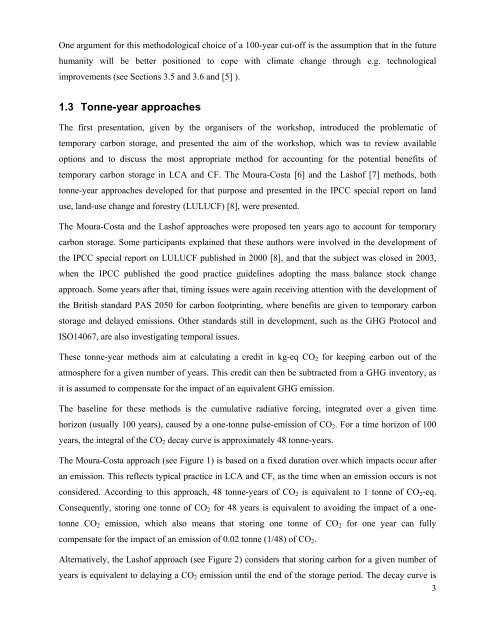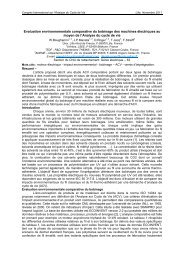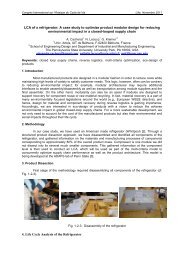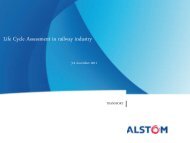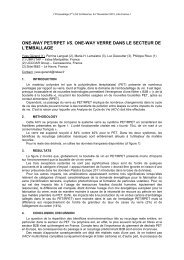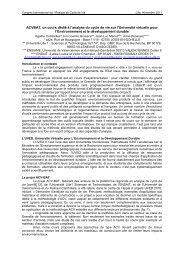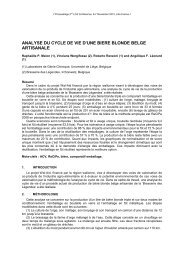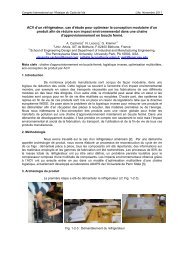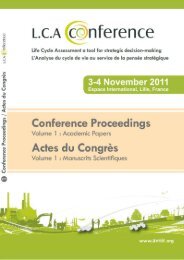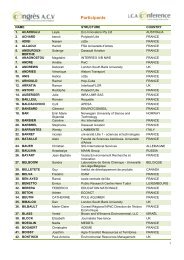Assessing Temporary Carbon Storage in Life Cycle Assessment and ...
Assessing Temporary Carbon Storage in Life Cycle Assessment and ...
Assessing Temporary Carbon Storage in Life Cycle Assessment and ...
Create successful ePaper yourself
Turn your PDF publications into a flip-book with our unique Google optimized e-Paper software.
One argument for this methodological choice of a 100-year cut-off is the assumption that <strong>in</strong> the future<br />
humanity will be better positioned to cope with climate change through e.g. technological<br />
improvements (see Sections 3.5 <strong>and</strong> 3.6 <strong>and</strong> [5] ).<br />
1.3 Tonne-year approaches<br />
The first presentation, given by the organisers of the workshop, <strong>in</strong>troduced the problematic of<br />
temporary carbon storage, <strong>and</strong> presented the aim of the workshop, which was to review available<br />
options <strong>and</strong> to discuss the most appropriate method for account<strong>in</strong>g for the potential benefits of<br />
temporary carbon storage <strong>in</strong> LCA <strong>and</strong> CF. The Moura-Costa [6] <strong>and</strong> the Lashof [7] methods, both<br />
tonne-year approaches developed for that purpose <strong>and</strong> presented <strong>in</strong> the IPCC special report on l<strong>and</strong><br />
use, l<strong>and</strong>-use change <strong>and</strong> forestry (LULUCF) [8], were presented.<br />
The Moura-Costa <strong>and</strong> the Lashof approaches were proposed ten years ago to account for temporary<br />
carbon storage. Some participants expla<strong>in</strong>ed that these authors were <strong>in</strong>volved <strong>in</strong> the development of<br />
the IPCC special report on LULUCF published <strong>in</strong> 2000 [8], <strong>and</strong> that the subject was closed <strong>in</strong> 2003,<br />
when the IPCC published the good practice guidel<strong>in</strong>es adopt<strong>in</strong>g the mass balance stock change<br />
approach. Some years after that, tim<strong>in</strong>g issues were aga<strong>in</strong> receiv<strong>in</strong>g attention with the development of<br />
the British st<strong>and</strong>ard PAS 2050 for carbon footpr<strong>in</strong>t<strong>in</strong>g, where benefits are given to temporary carbon<br />
storage <strong>and</strong> delayed emissions. Other st<strong>and</strong>ards still <strong>in</strong> development, such as the GHG Protocol <strong>and</strong><br />
ISO14067, are also <strong>in</strong>vestigat<strong>in</strong>g temporal issues.<br />
These tonne-year methods aim at calculat<strong>in</strong>g a credit <strong>in</strong> kg-eq CO 2 for keep<strong>in</strong>g carbon out of the<br />
atmosphere for a given number of years. This credit can then be subtracted from a GHG <strong>in</strong>ventory, as<br />
it is assumed to compensate for the impact of an equivalent GHG emission.<br />
The basel<strong>in</strong>e for these methods is the cumulative radiative forc<strong>in</strong>g, <strong>in</strong>tegrated over a given time<br />
horizon (usually 100 years), caused by a one-tonne pulse-emission of CO 2 . For a time horizon of 100<br />
years, the <strong>in</strong>tegral of the CO 2 decay curve is approximately 48 tonne-years.<br />
The Moura-Costa approach (see Figure 1) is based on a fixed duration over which impacts occur after<br />
an emission. This reflects typical practice <strong>in</strong> LCA <strong>and</strong> CF, as the time when an emission occurs is not<br />
considered. Accord<strong>in</strong>g to this approach, 48 tonne-years of CO 2 is equivalent to 1 tonne of CO 2 -eq.<br />
Consequently, stor<strong>in</strong>g one tonne of CO 2 for 48 years is equivalent to avoid<strong>in</strong>g the impact of a onetonne<br />
CO 2 emission, which also means that stor<strong>in</strong>g one tonne of CO 2 for one year can fully<br />
compensate for the impact of an emission of 0.02 tonne (1/48) of CO 2 .<br />
Alternatively, the Lashof approach (see Figure 2) considers that stor<strong>in</strong>g carbon for a given number of<br />
years is equivalent to delay<strong>in</strong>g a CO 2 emission until the end of the storage period. The decay curve is<br />
3


